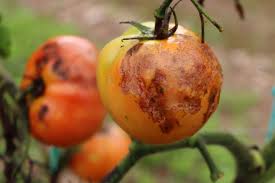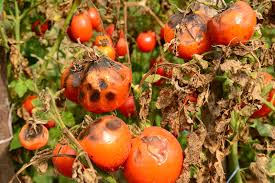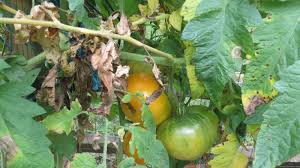1. Managing Damping-Off Disease in Tomato Seedlings
i. Caused by: Pythium aphanidermatum, P. ultimum, Phytophthora capsici, P. parasitica (Phylum: Heterokontophyta, Class: Oomycetes, Order: Peronosporales, Family: Pythiaceae)
Rhizoctonia solani (Phylum: Basidiomycota, Class: Basidiomycetes, Order: Polyporales, Family: Corticiaceae)
ii. Symptoms: This disease causes seed rot, pre-emergence damping-off, post-emergence damping-off, and stem rot. Pre-emergence damping-off is the decay of seedlings before they emerge through the soil.
Post-emergence damping-off starts as dark, soft lesions on the stem near the soil line, which may turn brown to nearly black. Infected seedlings fall, wither, and die.
This disease commonly occurs in patches in nursery beds or scattered in fields with direct-seeded crops. Heavily infested soils may cause widespread seedling death.
iii. Conditions for Development: Seedlings are most vulnerable during the first two weeks after sowing. Overwatering, overcrowding, poor ventilation in nurseries, cool, damp, cloudy weather, poorly drained soils, poor light quality, and excessive nitrogen nutrition favor disease development.
iv. Management: Use high-quality seed and chemical- or heat-pasteurized planting medium. Avoid excessive watering and poorly drained field areas. Construct raised beds higher than 35 cm to improve drainage. Planting when soil is warm promotes rapid seed germination and vigorous seedlings that resist disease.
Apply 35% Etridiazole WP 3,000X immediately after transplanting by drenching to reduce pathogen populations. Fungicide seed treatment can also prevent severe damping-off.
Read Also: How to Grow, Use and Care for Whitetinge Sedge Grass (Carex albicans)
2. Managing Early Blight Disease on Tomato Leaves, Stems, and Fruits

i. Caused by: Alternaria solani (Phylum: Ascomycota, Class: Dothideomycetes, Order: Pleosporales, Family: Pleosporaceae)
ii. Symptoms: Early blight affects foliage, stems, and fruit, causing severe damage at all growth stages. Small brown-black lesions appear on older leaves, often surrounded by yellowing tissue. Spots enlarge rapidly, showing concentric rings.
Stem lesions start small and dark but enlarge with concentric rings and light centers. Fruit infection occurs through the calyx or stem, with lesions showing concentric rings that can cover entire fruit. Severe infection causes defoliation, reducing fruit size, number, and marketability.
iii. Conditions for Development:
The pathogen can be seed-borne and survives in soil on crop debris and volunteer tomatoes. It spreads rapidly by wind, rain, and farm tools.
Extended leaf wetness from dew or rain promotes disease, while stressed plants, especially those attacked by nematodes or during fruiting, are more susceptible.
iv. Management: Use resistant or tolerant cultivars, treated seeds, and pathogen-free seedlings. Pasteurize soil in seedbeds using steam, fumigants, or solarization, or use pathogen-free artificial soil mixes.
Employ long crop rotations, eradicate weeds and volunteer plants, fertilize properly, and maintain vigorous growth. Avoid overlapping tomato plantings in adjacent areas. Apply fungicides such as copper hydroxide regularly if necessary.
Read Also: How to Grow, Use and Care for Whitegrass (Leersia virginica)
3. Managing Late Blight Disease Affecting Tomato Leaves, Stems, and Fruits

i. Caused by: Phytophthora infestans (Phylum: Heterokontophyta, Class: Oomycetes, Order: Peronosporales, Family: Pythiaceae)
ii. Symptoms: The fungus infects all above-ground parts. Leaf lesions are irregular, water-soaked patches that enlarge, showing white fungal growth beneath, later drying to brown.
Stem lesions start as water-soaked areas that kill stem sections or dry to dark brown spots. Fruit lesions appear as firm, olive to brown irregular patches with rough, leathery surfaces, which may spread to cover the entire fruit.
iii. Conditions for Development:
Sporangia develop on leaves and spread during cool to moderate temperatures (10-25˚C) with humidity above 75% for two or more days. Free water on plant surfaces is necessary for spore germination.
The fungus survives on tomato and potato plants and in potato tubers but not saprophytically. Wind and rain spread sporangia widely.
iv. Management: Use resistant cultivars such as ‘Hualien ASVEG 17’ and disease-free seedlings. Avoid planting tomatoes near potatoes. Apply effective fungicides like Famoxadone + Cymoxanil, Azoxystrobin, or Dimethomorph.
Remove and destroy potato cull piles and volunteer potato plants near tomato fields. Use rain shelters to reduce disease severity.
4. Managing Fusarium Wilt Disease in Tomato Plants
i. Caused by: Fusarium oxysporum f. sp. lycopersici (Phylum: Ascomycota, Class: Sordariomycetes, Order: Hypocreales, Family: Ketriaceae)
ii. Symptoms: Lower leaves turn yellow, often only on one side of the plant, then yellowing progresses upwards. Leaves dry and turn brown. Plants wilt during the day but recover at night initially; wilting worsens until permanent. Vascular browning extends through the stem and petioles, a key identification symptom.
iii. Conditions for Development:
Disease favors soil and air temperatures around 28˚C, optimum soil moisture, low nitrogen and phosphorus, high potassium, acidic soils, short day length, and low light.
The pathogen enters through root wounds and spreads via the vascular system. It is soil-borne and persists for many years. Dissemination occurs through seed, transplants, stakes, infested soil on machinery, wind, and water.
iv. Management: Use pathogen-free seed and rotate crops for 5 to 7 years. Flooded rice in rotation reduces losses. Adjust soil pH to 6.5-7.0 and use nitrate nitrogen rather than ammoniacal nitrogen.
Prevent movement of infected seed, plants, and infested soil. Employ resistant cultivars or graft tomato plants onto resistant rootstocks. Resistance to various pathogen races is available.
5. Managing Southern Blight Disease Near Soil Line on Tomato Plants

i. Caused by: Sclerotium rolfsii (imperfect stage); Athelia rolfsii (perfect stage) (Phylum: Basidiomycota, Class: Basidiomycetes, Order: Atheliales, Family: Atheliaceae)
ii. Symptoms: Infection usually appears on plant parts near or in soil, affecting plants of any age. The main symptom is brown to black stem rot near the soil line, which can girdle the stem, causing sudden and permanent wilting.
White mycelium grows abundantly on lesions under moist conditions, with tan to reddish-brown spherical sclerotia developing on mycelial mats. The fungus also invades fruit in contact with infested soil.
iii. Conditions for Development:
High soil moisture and temperature promote disease development. Dense planting and frequent irrigation increase infection risk. Sclerotia survive in soil for years and spread via surface water or infested soil movement. The fungus has a broad host range.
iv. Management: Implement good sanitation by removing and burning infected plants to prevent disease buildup. Deep plowing buries sclerotia and debris. Rotate crops for at least three years with non-susceptible species like corn or small grains.
Fumigation and soil fungicides like Etridiazole are effective. Use solarization with polyethylene sheeting and biological control with antagonistic fungi such as Bacillus subtilis, Gliocladium virens, and Trichoderma species.
Plastic mulch or staking reduces soil splash. Amend acid soils before planting and use resistant cultivars when available.
6. Managing Black Leaf Mold (Cercospora Leaf Mold) on Tomato Plants
i. Caused by: Pseudocercospora fuligena (Phylum: Ascomycota, Class: Dothideomycetes, Order: Capnodiales, Family: Mycosphaerellaceae)
ii. Symptoms: Yellow spots develop on the upper leaf surface in early infection stages, with gray to black conidial sporulation mainly on the lower leaf surface under humid conditions. Lesions may merge to cover large areas. Leaves roll upward, exposing the lower surface and begin to dry.
Do you have any questions, suggestions, or contributions? If so, please feel free to use the comment box below to share your thoughts. We also encourage you to kindly share this information with others who might benefit from it. Since we can’t reach everyone at once, we truly appreciate your help in spreading the word. Thank you so much for your support and for sharing!

